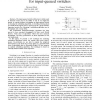40 search results - page 4 / 8 » Input Queued Switches: Cell Switching vs. Packet Switching |
SPAA
2005
ACM
14 years 1 months ago
2005
ACM
Switching cells in parallel is a common approach to build switches with very high external line rate and a large number of ports. A prime example is the parallel packet switch (in...
INFOCOM
2006
IEEE
14 years 1 months ago
2006
IEEE
— The input-queued switch architecture is widely used in Internet routers, due to its ability to run at very high line speeds. A central problem in designing an input-queued swit...
SJ
2010
13 years 6 months ago
2010
—With the rapid increase of real-time applications, jitter, delay, and throughput have become the three important QoS criteria in the scheduling of input-queued (IQ) switches wit...
IPPS
1998
IEEE
13 years 12 months ago
1998
IEEE
Switch-based interconnects are used in a number of application domains including parallel system interconnects, local area networks, and wide area networks. However, very few swit...
HOTI
2002
IEEE
14 years 17 days ago
2002
IEEE
High-performance input-queued switches require highspeed scheduling algorithms while maintaining good performance. Various round-robin scheduling algorithms for Virtual Output Que...

